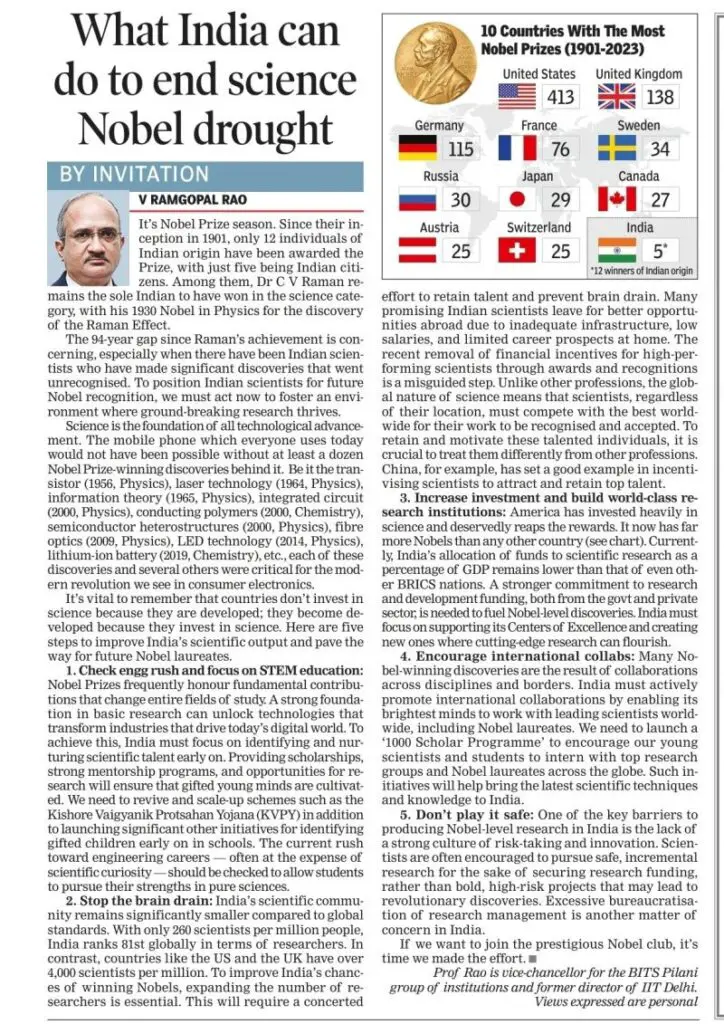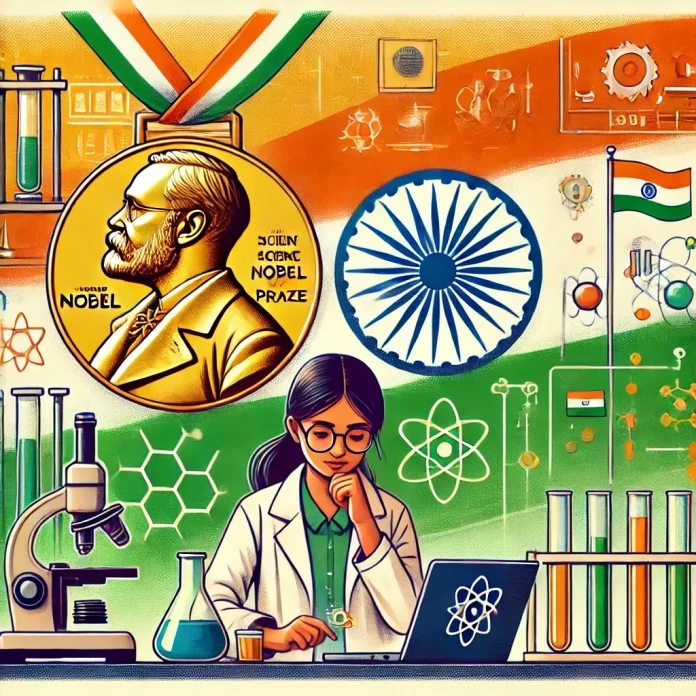In a thought-provoking piece for The Times of India, Prof. V Ramgopal Rao, former director of IIT Delhi, outlines crucial strategies for India to end its prolonged drought in the Nobel Prize in Science for India. The article, published on Sunday, October 13, 2024, highlights the concerning statistic that only 12 individuals of Indian origin have been awarded Nobel Prizes since 1901, with C V Raman remaining the sole Indian to win in the sciences.
Nobel Prize in Science for India

Rao emphasizes the need for immediate action, given that 84 years have passed since Raman’s groundbreaking achievement. He points out that despite Indian scientists making significant discoveries, many remain unrecognized on the global stage.
Strategies to Enhance India’s Scientific Landscape – Nobel Prize in Science for India
To address this, Rao proposes five key steps:
1. Nurture Scientific Talent Early: Focus on STEM Education
Fostering an early interest in STEM (Science, Technology, Engineering, and Mathematics) is essential to developing scientific talent. Rao suggests implementing initiatives such as scholarships, mentorship programs, and research opportunities to guide young students toward a scientific career. An example of this is India’s ‘Kishore Vaigyanik Protsahan Yojana’ (KVPY), a national program that identifies and supports gifted students from an early stage, offering scholarships and mentorships for those showing promise in scientific research.
2. Retain Talent by Stopping Brain Drain
Brain drain, where talented individuals leave India for better opportunities abroad, is a significant issue. To combat this, Rao emphasizes the need for India to improve research infrastructure, offer competitive salaries, and ensure that career prospects for scientists are attractive. He criticizes the recent removal of financial incentives for high-performing scientists, calling it a misguided policy that may discourage top talent from remaining in the country. For example, offering competitive grants and resources can keep scientists working within Indian institutions.
3. Invest in World-Class Research Institutions
Rao advocates for increased funding for scientific research, similar to the American model, where science receives significant government backing. By allocating a higher percentage of GDP to scientific research, India could build more world-class research institutions that attract top minds globally. As a result, this could lead to breakthroughs in critical fields such as biotechnology, AI, and sustainable energy.
4. Encourage International Collaboration
Promoting cross-border and interdisciplinary research is another key strategy. By encouraging partnerships between Indian and foreign institutions, the scientific community can benefit from diverse perspectives and resources. Rao’s suggestion of launching a ‘1000 Scholar Programme’ to connect young Indian scientists with Nobel laureates is a prime example. Such a program would enable young scholars to learn from the world’s best, fostering a culture of international collaboration and innovation.
5. Foster Risk-Taking and Innovation in Research
India’s scientific research often leans toward incremental advances rather than groundbreaking discoveries. Rao argues for creating an environment that supports high-risk, high-reward projects. For instance, government and private sector funding could prioritize projects with the potential for major scientific breakthroughs, rather than focusing only on safe, predictable research outcomes. Encouraging a more entrepreneurial mindset in the research community could lead to significant innovations.
Rao underscores the importance of these steps by highlighting India’s current standing in Nobel Prizes. The accompanying infographic shows India lagging with just 5 prizes, compared to the United States’ 413 and the United Kingdom’s 138.
The article serves as a call to action for policymakers, educators, and the scientific community. Rao concludes that if India aspires to join the ranks of Nobel Prize-winning nations, concerted efforts must create an environment where groundbreaking research can thrive.
As India continues its journey towards becoming a global scientific powerhouse, Rao’s insights provide a roadmap for nurturing the next generation of Nobel laureates and elevating the country’s status in the international scientific community.
10 FAQs and Answers about the Nobel Prize in Science for India
Here are the 10 FAQs and answers:
1. Why has India struggled to win Nobel Prizes in science since C.V. Raman’s achievement?
India has faced challenges in winning science Nobel Prizes due to inadequate research infrastructure, limited funding, brain drain of talented scientists, and a lack of focus on cutting-edge, high-risk research areas.
2. What are the main challenges facing Indian scientists in conducting Nobel-worthy research?
Indian scientists often face challenges like insufficient funding, limited access to state-of-the-art equipment, bureaucratic hurdles, and a research culture that sometimes prioritizes quantity over quality and breakthrough innovations.
3. How can India improve its STEM education to nurture future Nobel laureates?
India can enhance STEM education by focusing on early talent identification, providing scholarships and mentorship programs, encouraging curiosity-driven learning, and creating more opportunities for hands-on research experiences at younger ages.
4. What role does brain drain play in India’s lack of science Nobel Prizes?
Brain drain significantly impacts India’s Nobel Prize potential as many talented scientists leave for better opportunities abroad, reducing the pool of top researchers working within Indian institutions and potentially contributing to Nobel-worthy discoveries for India.
5. How does India’s research funding compare to countries with more Nobel laureates?
India’s research funding as a percentage of GDP is generally lower compared to countries with more Nobel laureates. Increasing investment in scientific research and development is crucial for competing globally in cutting-edge research.
6. What strategies can India adopt to create world-class research institutions?
India can create world-class research institutions by increasing funding, fostering autonomy, promoting interdisciplinary collaboration, attracting top global talent, and focusing on areas of strategic importance and potential breakthrough research.
7. How important are international collaborations for increasing India’s chances of winning Nobel Prizes?
International collaborations are crucial as they expose Indian scientists to global research trends, facilitate knowledge exchange, provide access to advanced facilities, and increase the visibility and impact of Indian research on the world stage.
8. What initiatives has the Indian government implemented to support high-level scientific research?
The Indian government has implemented various initiatives such as the establishment of new IITs and IISERs, the INSPIRE faculty scheme, and increased funding for certain scientific departments. However, more comprehensive and sustained efforts are needed.
9. How can India foster a culture of innovation and risk-taking in scientific research?
India can foster innovation by encouraging high-risk, high-reward research projects, providing better protection for intellectual property, creating more industry-academia partnerships, and recognizing and rewarding breakthrough research over incremental progress.
10. What impact would winning more Nobel Prizes have on India’s global scientific standing?
Winning more Nobel Prizes would significantly enhance India’s global scientific reputation, attract more international collaborations and funding, inspire younger generations to pursue scientific careers, and potentially lead to increased government and private sector investment in research and development.
Why Mahatma Gandhi never Won the Nobel Prize for Peace?

